Potřebujeme váš souhlas k využití jednotlivých dat, aby se vám mimo jiné mohly ukazovat informace týkající se vašich zájmů. Souhlas udělíte kliknutím na tlačítko „OK“.
ASTM E136-12
Standard Test Method for Behavior of Materials in a Vertical Tube Furnace at 750°C
Automaticky přeložený název:
Standardní zkušební metoda pro chování materiálů ve vertikální trubkové peci při 750 ° C
NORMA vydána dne 1.8.2012
Informace o normě:
Označení normy: ASTM E136-12
Poznámka: NEPLATNÁ
Datum vydání normy: 1.8.2012
Kód zboží: NS-41490
Počet stran: 11
Přibližná hmotnost: 33 g (0.07 liber)
Země: Americká technická norma
Kategorie: Technické normy ASTM
Kategorie - podobné normy:
Ohnivzdornost stavebních materiálů a prvků
Stavební hmoty obecně
Anotace textu normy ASTM E136-12 :
Keywords:
building materials, combustion, heated tube, limited combustion, Setchkin furnace, tube furnace, vertical tube furnace, ICS Number Code 13.220.50 (Fire-resistance of building materials and elements), 91.100.01 (Construction materials)
Doplňující informace
| Significance and Use | ||||||||||
|
While actual building fire exposure conditions are not duplicated, this test method will assist in indicating those materials which do not act to aid combustion or add appreciable heat to an ambient fire. Materials passing the test are permitted limited flaming and other indications of combustion. |
||||||||||
| 1. Scope | ||||||||||
|
1.1 This fire-test-response test method covers the determination under specified laboratory conditions of combustion characteristics of building materials. 1.2 Limitations of this fire-test response test method are shown below. 1.2.1 This test method does not apply to laminated or coated materials. 1.2.2 This test method is not suitable or satisfactory for materials that soften, flow, melt, intumesce or otherwise separate from the measuring thermocouple. 1.2.3 This test method does not provide a measure of an intrinsic property. 1.2.4 This test method does not provide a quantitative measure of heat generation or combustibility; it simply serves as a test method with selected (end point) measures of combustibility. 1.2.5 The test method does not measure the self-heating tendencies of materials. 1.2.6 In this test method materials are not being tested in the nature and form used in building applications. The test specimen consists of a small, specified volume that is either (1) cut from a thick sheet; (2) assembled from multiple thicknesses of thin sheets; or (3) placed in a container if composed of granular powder or loose-fiber materials. 1.2.7 Results from this test method apply to the specific test apparatus and test conditions and are likely to vary when changes are made to one or more of the following: (1) the size, shape, and arrangement of the specimen; (2) the distribution of organic content; (3) the exposure temperature; (4) the air supply; (5) the location of thermocouples. 1.3 This test method includes two options, both of which use a furnace to expose test specimens of building materials to a temperature of 750°C (1382°F). 1.3.1 The furnace for the apparatus for Option A consists of a ceramic tube containing an electric heating coil, and two concentric vertical refractory tubes. 1.3.2 The furnace for the apparatus for Option B (Test Method E2652) consists of an enclosed refractory tube surrounded by a heating coil with a cone-shaped airflow stabilizer. 1.4 This test method references notes and footnotes that provide explanatory information. These notes and footnotes, excluding those in tables and figures, shall not be considered as requirements of this test method. 1.5 The values stated in SI units are to be regarded as standard. The values given in parentheses are for information only. 1.6 This standard is used to measure and describe the response of materials, products, or assemblies to heat and flame under controlled conditions, but does not by itself incorporate all factors required for fire-hazard or fire-risk assessment of the materials, products, or assemblies under actual fire conditions. 1.7 Fire testing is inherently hazardous. Adequate safeguards for personnel and property shall be employed in conducting these tests. 1.8 This standard does not purport to address all of the safety concerns, if any, associated with its use. It is the responsibility of the user of this standard to establish appropriate safety and health practices and determine the applicability of regulatory limitations prior to use. |
||||||||||
| 2. Referenced Documents | ||||||||||
|
Podobné normy:
Historická
1.4.2011
Historická
1.4.2011
Historická
1.4.2011
Historická
1.12.2013
Historická
1.4.2014
Historická
1.4.2011


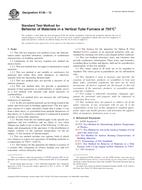
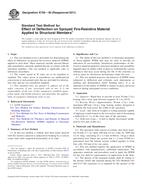 ASTM E759-92(2011)..
ASTM E759-92(2011)..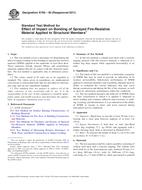 ASTM E760-92(2011)..
ASTM E760-92(2011)..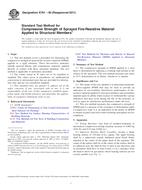 ASTM E761-92(2011)..
ASTM E761-92(2011)..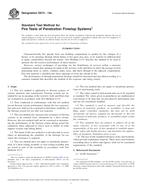 ASTM E814-13a
ASTM E814-13a ASTM E84-14
ASTM E84-14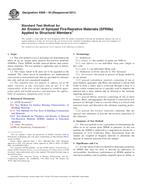 ASTM E859-93(2011)..
ASTM E859-93(2011)..
 Cookies
Cookies
